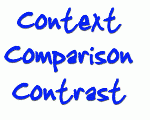Part 1: Analytics: Is it Fun or Easy?
Part 2: Ambiguity is Opportunity
Part 3: Segmentation Finds Motivation
Why Segmentation?
Segmentation is the principle that people come to the website for many different reasons, they enter at many different points, the see different pages, and are looking for many different pieces of information. 
Aggregate = Inaccurate
Funny enough, when we build reports on aggregate data (page views, visitors, top 10 pages, top 10 search terms) we are doing exactly that. Aggregate numbers view people as a herd of cattle, all with the same motives, behaviors and views. Segmentation allows a deeper examination of the website and the different types of people and their motivations.
Analytics finds Behavior based on Expectation
By simply segmenting visitors based on their keyword searches, motivation can be determined. By segmenting those same visitors based on goal completion and the entry point of the site, you can begin to compare behavior alongside the motivation. Comparisons allow new ways to interpret the data, and find areas of the website that need immediate improvement. Not all products can be sold the same, so why measure them the same?
Context, Context, Context
Building context is a primary step in developing new ways of viewing data. The more we know about a group of visitors, the more we can understand them. By viewing people as the complex organisms that they are, we can begin to develop the site around them and make changes suited to best market to that segment. This isn’t a difficult step; it’s actually very simple by using the 3C’s of Analytics: Context, Contrast & Comparison.
Context is simply building multiple data points into a specific view of activity. Essentially, the more data points involved, the better the story becomes. Adding content to a segment tells a particular story about a specific group of people and what they encountered on your website.

Test poorly performing segments, and grow the higher segments. Compare segments and keyword rankings to be sure that you are targeting the right words. Get a clear picture on exit rates by finding the segment that is contributing the most. Comparing and contrasting segments is the basis of learning, and it is the easiest method to find opportunities for growth in your marketing. You may find that your best ranking keywords, the ones bringing in the most traffic, are also the worst performing group. Only segmenting and building context will allow that exploration.
More Data Points = More Understanding
The simple conclusion to this type of analysis is that there must be multiple conversion goals. One conversion rate doesn’t tell the story of who came to the website, what they expected to see, what they did see, and how they reacted to it. Multiple conversion rates; based on keywords, actions, product types, price points, keyword rankings, navigation methods are just a few of the ways that one can build conversion segments.
Action-based conversions, such as video views, navigation tendencies, point to the behavior of people within a segment and can provide insight as to how people respond when they interact with elements within the website. Understanding the actions and how they affect conversions will provide direction for continued development of interactions within the website.
Part 4: Compared to What?
Related Articles:
Segmentation: Analytics According to Captain Kirk
Social Media Under the Microscope
Multi-Channel Marketing and Self-Fulfilling Prophesy

Segmentation helps us reach our goals and evaluate if the strategy we’ve used to reach our goal was or wasn’t the correct one. In my opinion, considering the results alone without analizing them according to the target we’re aiming it is missing something important.
In my opinon, segmentation is key to the fundament aspect of marketing – return on investement. Like all promotional activity cost must be quantfied. Great post
Katie
________________
Company Formation
Segmentation is crucial. It provides us with a huge insight as regards the extent to which our goals are reached or not and helps us analyze the target that is actually visiting our site or consuming our product or service.
This is really good advice and I know from experience that paying attention to these aspects of Analytics can really pay off. Whenever I look at my Analytics data I make sure to ask myself “What does this really mean?” and once I figure that out I think about what I can do to improve it.
This is really good advice and I know from experience that paying attention to these aspects of Analytics can really pay off. Whenever I look at my Analytics data I make sure to ask myself “What does this really mean?” and once I figure that out I think about what I can do to improve it.
nice post, i agree. the more we focus on a specific segmentation than more effective our action.
I agree with Monica, segmentation is as vital as the rest of the analytics. Without which, everything else false into pieces. :)
I was blindly adding content until I started using goggle analytics to see what my visitors were interested in then began targeting those areas, and it’s working well.
Using aggregate data is obviously a terrible idea, but sadly, it’s the first thing people see when they login to their analytics.
With the incredible ability to segment available (even in free tools) there’s really no excuse not to get more from your data.
Hi,
I heard a claim from a colleague today that: “It is not legal to segment e-mail campaigns on previous purchase behavior”.
So it is for example not legal to send an email containing offers on DVDs to all the customers who have purchased DVDs. And an email with CDs offers to all customers who have purchased CDs.
Is this true?
Great post. Segmentation is the cornerstone of all marketing activity.
Good post! How do you view using previous purchase information for segmentation? Some people find it unethical, so I am still considering whether I should use this information for my newsletters.
Matt, you really made a great point with segmentation. Not to mention a great analogy about the herd of cattle.
I can’t speak for the cows, but humans making significant business or money decisions from high-level (unsegmented) data – based on false premises, can lead to a slippery slope.
I really enjoyed this series – I do most of what you are saying but it offers some great reminders to reinforce what I’m not doing as diligently.
Excellent post I agree segmentation is very important in many aspects of marketing.
I can’t speak for the cows, but humans making significant business or money decisions from high-level (unsegmented) data – based on false premises, can lead to a slippery slope.